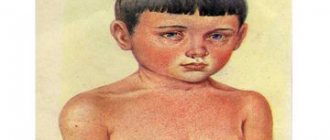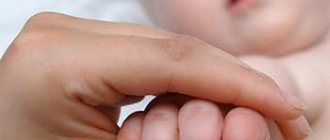In all commercials and photographs in magazines, newborns and infants look like pink peaches - their skin is soft, velvety, even, uniform in color. In life, things are often completely different. The color of a baby's skin is striking in its diversity and variability. The greatest amount of anxiety and worry among young mothers and fathers is caused by the marbled skin of a child, when the vessels are visible and form a pattern reminiscent of the appearance of marble. We will tell you what it is and whether it is dangerous in this article.
Pale skin in children aged 0 to 1 year
Marbling of the skin in children under 1 year of age is the norm, since their autonomic system is still adapting to the new world around them. Gradually, the vessels will get used to changes in ambient temperature and begin to respond to it, expanding and contracting when necessary.
In a situation where marbling of the skin in children under 1 year of age is accompanied by high fever and pallor around the lips, you should definitely consult a doctor. Since this is already a symptom of the disease. Although sometimes it happens that it is simply a consequence of the baby’s severe overheating.
Pale skin in children aged 5 to 12 years

Marbling of the skin in children aged 5 years and older may indicate the presence of any diseases:
- Livedo Racemosa is a symptom of diseases such as lupus erythematosus, syphilis, tuberculosis, malaria, chronic tonsillitis, or one of the diseases of the cardiovascular system.
- Livedo Reticularis a Frigore is a consequence of severe hypothermia of the body. This condition does not last long and goes away with normalization of the temperature surrounding the child. But in some cases, such a pattern on the skin may indicate a malfunction of the internal organs.
- Livedo Reticularis a Celore and Ienticelaris - occurs as a result of overheating of the child.
In principle, marbled skin in a child with a fever is already a dangerous condition. Since this is a sign of an inflammatory process in the body. In this case, it is impossible to do without the help of a specialist.
In order not to take risks when the disease appears, you must show them to the doctor.
Interesting Facts
A few facts about marble leather:
- Marbling of the skin may appear after a long and strong cry. It is not dangerous and goes away on its own.
- In 2% of “marbled” babies, this pattern on the skin persists as an episodic pattern up to 3 years of age.
- In 1-2% of newborns and infants who have no health problems, the true cause of marbled skin cannot be determined. In this case, doctors indicate that the causes are idiopathic.
- Children's physiological marbling of the skin can be inherited. If mom or dad’s skin was like this after birth, then the child’s skin will most likely also temporarily become marbled.
- Children who are overfed quite often develop physiological marbling.
- A persistent marble “mesh” on a baby's skin may mean that he or she has increased intracranial pressure. You should definitely visit a neurologist.
- 95% of children born with genetic Edwards and Down syndromes are characterized by marbling.
- In children who, after birth, showed their parents a “beautiful” marble mesh on the skin, at a later age the skin is more susceptible to injury - they more often develop bruises and hematomas, even with a minor blow or careless touching of hard objects.
See the following video for all about the features of the skin of newborns.
medical reviewer, psychosomatics specialist, mother of 4 children
Localization of pallor
The child’s condition depends on where the pallor is localized. That is, the appearance of marbling of the skin in one place or another can tell what kind of pathology the baby has. For example, if marbling appears on the face, around the nose and lips, this may be a sign that the child has problems with the heart or nervous system. In this case, only a cardiologist and, accordingly, a neurologist can make an accurate diagnosis.
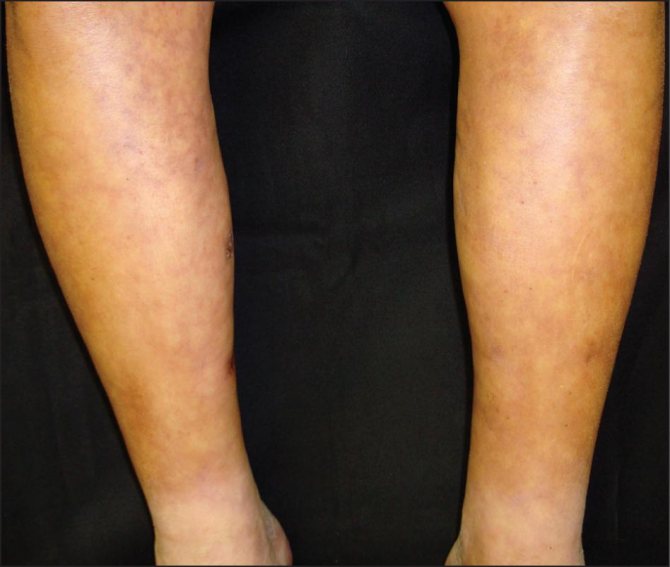
If the marbled skin of a child and an adult covers the entire body, then this may indicate an incorrectly or incompletely formed vascular system. It is located too close to the surface of the skin, the network of blood vessels is clearly visible in case of overheating or hypothermia. Such manifestations usually disappear after the ambient temperature normalizes.
Marbled skin on the legs is an early sign of vascular erythema, a pathology manifested by venous spasms. Most often it occurs in adults.
Pale skin with streaks of blood vessels on the hands is a common sign of mild frostbite. It is observed in the cold season in children and adults, and goes away when the person warms up.
If the skin is pale and thin on the palms of the hands, then this is most likely a neurological disease, and this situation cannot be avoided without proper treatment.
There is no need to look for the causes and methods of treating marble disease in children if it appears on the feet. This phenomenon is a genetic feature of the baby. It is not pathological or hazardous to health. A doctor's help is not required.
What it is
Marbled white skin is a broad concept. The presence of marbled skin in a child can be both a type of normal and a symptom of a disease. In some cases, an unusual shade can appear on the arms or cheeks.
Most often, a network of blood vessels is visible in fair-skinned infants. In dark-skinned people this phenomenon occurs very rarely.
Physiological origin
Most often, a marbled shade of the skin is normal. In children they are less protected than in adults.
Infants have not yet developed the function of thermoregulation. The vessels are located very close to the skin. Under the influence of even weak unfavorable factors, some of them expand, while others contract. This provokes the appearance of marbled skin in children.
Sometimes a change in the color of the skin of infants is observed during bathing and changing clothes.
The physiological causes of marble tint in infants do not require intervention. Typically, this phenomenon occurs if there has been a difficult and prolonged labor or a disease of the birth canal, and the baby has experienced oxygen starvation for a long time.
- A tan. Marbling of the skin of a baby also appears on tanned skin. If such a symptom appears, you need to reduce the frequency of exposure to the sun.
- When temperatures change. The slightest changes in temperature can cause a rapid change in skin color. This is one of the most common reasons why marble stains occur.
- Close location of capillaries in relation to the skin. Sometimes a child has thin skin through which blood vessels can be seen. Another reason why a child has marbled skin is a small layer of fatty tissue.
Pathological origin
Sometimes an unnatural marbled skin tone signals the development of diseases. In this case, it is combined with other symptoms of the pathology.
Quite often, the cause of marbled skin in a child under 7 years old can be:
- acquired and congenital heart defects;
- brain damage;
- pathologies of the nervous system.
In this case, the baby's skin may turn blue. She is very pale and thin, cold to the touch and prone to excessive sweating.
All pathological causes of marbling and cyanosis are quite easily diagnosed in the children's department of a medical institution. Parents can find out about the problem only after the baby’s temperature rises. His hands will be cold, and a characteristic vascular network will appear on them.
- Dyschromia. This is what is called a pigmentation disorder. Uneven accumulation of melanin is often observed in children under 2 years of age and indicates some rare autoimmune pathologies.
- Livedo. This is a disease of the skin and subcutaneous tissue in infants, developing as a result of vasomotor disorders. Leads to the appearance of a marbled bluish pattern.
According to Dr. Komarovsky, marbling also appears in premature babies.
Rare causes
A child sometimes develops a rare marbling syndrome. The causes of the pathology are not fully understood. Apparently, it is associated with the pathological condition of the blood vessels. With such a rare disease, an asymmetrical structure of the body and face, upper and lower extremities is noticed.
Sometimes the skin can acquire a specific purple tint.
Marbling of the skin is accompanied by flaming giant moles and microcephaly of the brain.
Marbling syndrome is poorly understood. There are only a few hundred registered cases of pathology known in the world.
- Genetic predisposition. If the parents have a white, marbled skin color, then the children are likely to have the same.
- Overfeeding. When children under one year are overfed, the volume of circulating blood increases. This has a bad effect on the condition of blood vessels.
Types of leather marbling
Conventionally, marbling of the skin is divided into 2 main types - physiological and pathological. The physiological type is caused by exposure to the external environment and is not related to diseases of the body. Physiological skin marbling does not require treatment - it is a short-term phenomenon that goes away on its own after the body returns to comfortable conditions.
The pathological type is characterized by the fact that marbled skin is one of the manifestations of a disease. You need to understand that this is not the main and certainly not the only symptom of the disease. Typically, the pathology has several manifestations, some of which include pale skin with visible vessels.
Physiological causes of pale skin

Mentioning that pallor of the skin is one of the symptoms of many diseases, we can identify a number of pathologies in which this manifestation is mandatory. When diagnosing the disease, other characteristic symptoms are also taken into account.
The causes of marbled skin in a child are quite varied:
- Change in ambient temperature - cold or hot. It is quite easy to combat this phenomenon; you need to dress the child appropriately for the weather or room temperature. Ideally, it should be 23-27 degrees with high humidity.
- Exercise stress. In this case, no treatment is required.
- Binge eating. This situation can only arise in infants. It is necessary to normalize his diet and review his diet. A pediatrician or nutritionist can help with this.
- If a child was born at 7 months, then pale skin is rather the norm. No special treatment is required as it will go away by 1 year.
- Weight deficiency. Pale skin for this reason is a logical phenomenon. It goes away on its own with normalization of nutrition.
Physiological origin
In 90% of cases, such skin in a child indicates completely understandable and harmless reasons. The skin of newborns is much thinner and more vulnerable than the skin of adults. It is more susceptible to any external influences, and primarily to temperature changes. If an adult, as a rule, does not feel a difference of 1-2 degrees at all, then for a newborn such a difference is very noticeable.
Thermoregulation in babies who have just been born is imperfect. And the circulatory system is just being rebuilt to operate independently, deprived of placental nutrition. The vessels and capillaries themselves are located too close to the skin. Under the influence of a variety of external factors, including temperature changes, some vessels can expand, while others can narrow. Those that expand through the skin appear redder, those that narrow through the skin appear more blue. This is how marbling is formed.
The skin can sometimes have such an unusual color if the child is bathed in cool water, changed clothes in a cool room, or it can be almost constantly marbled, only slightly changing the intensity and outline of the marble pattern. There are no other alarming symptoms with physiological marbling, the child is healthy, eats well, sleeps, develops and gains weight within average limits. Parents are satisfied with absolutely everything except the baby’s skin tone.
This condition does not require any treatment or other measures. Usually, by 3-4 months, the child’s thermoregulation is established, blood circulation in small vessels improves, and the mesh disappears by itself. This process may take a long time, but after six months a physiologically determined marble mesh is already a rarity.
Most often, such harmless natural marbling is characteristic of children who were born after a difficult and long labor, babies who experienced hypoxia while in the womb, premature toddlers, as well as children who suffered an intrauterine infection.
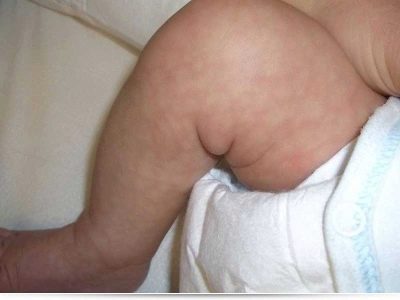
Pathological factors

The causes and treatment of marbled skin in children in case of pathology are identified by specialists based on a number of additional signs and symptoms:
- Pale skin as a sign of lack of oxygen during pregnancy. Treatment for this condition is to eliminate oxygen starvation. The methodology is selected only by a specialist based on the patient’s individual indications.
- Low level of hemoglobin in the blood. Confirmed by a special blood test. Therapy for this condition consists of correcting the diet with the addition of a number of foods rich in iron and vitamins.
- Heart disease. The treatment method and medications are selected by a cardiologist. Self-medication can lead to the death of the patient.
- Dropsy or cystic formation in the central nervous system. Treatment includes taking special medications or surgery. Therapy is prescribed only by a specialist. Self-medication is impossible.
- Disruption of vegetative-vascular dystonia. This disorder has the longest and most complex treatment. The child must follow a daily routine. Take multivitamins, eat a prescribed diet, exercise regularly, and in some cases, consult a psychologist. Drug treatment is used extremely rarely; most often, a patient with such a diagnosis is prescribed physical therapy, during which the necessary drug is administered.
- There is no treatment as such for Down or Edwards syndrome. A psychologist helps a child adapt to society. At the same time, the doctor teaches the child’s family members how to treat the child correctly so that he feels comfortable.
Rare causes
There is a syndrome of skin marbling in medical encyclopedias. This is a very rare congenital disease that is associated with vascular pathology. Since 1970, only just over 200 cases of true marbling have been reported worldwide. In addition to the unusual appearance of the skin, abnormalities in the development of blood vessels cause other changes in the child’s body. All of them are perfectly diagnosed immediately after birth. True marbled skin is accompanied by microcephaly of the brain, giant nevi, including flaming nevi.
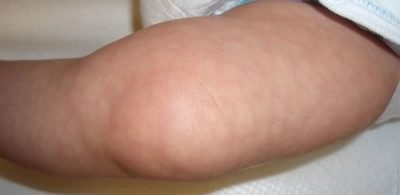
With a rare congenital disease, in addition to marbling, a child has asymmetry of the face and body, limbs, gross pathologies in the structures of the brain and central nervous system. The skin with this disease has a permanent purple tint. The vascular network is very clearly visible. To confirm such a diagnosis, a geneticist will have to go on a conference call with foreign colleagues, since in Russia the disease has been studied very little, and all the bright, described and relatively studied cases have been registered mainly in the West, although even there it is difficult to make predictions about congenital marbling - too little practice.
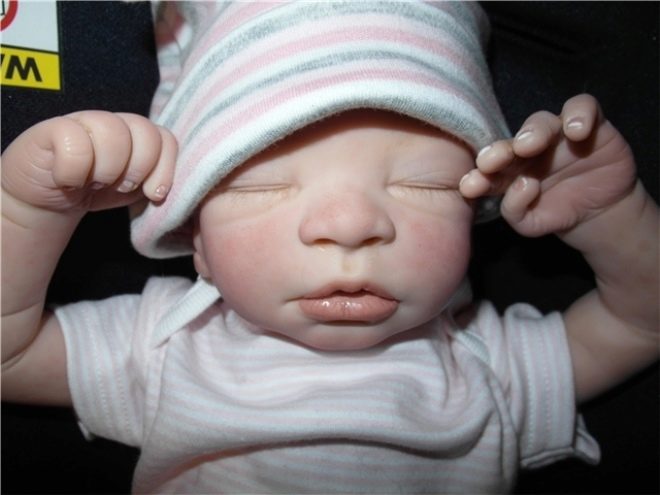
Complication of fever
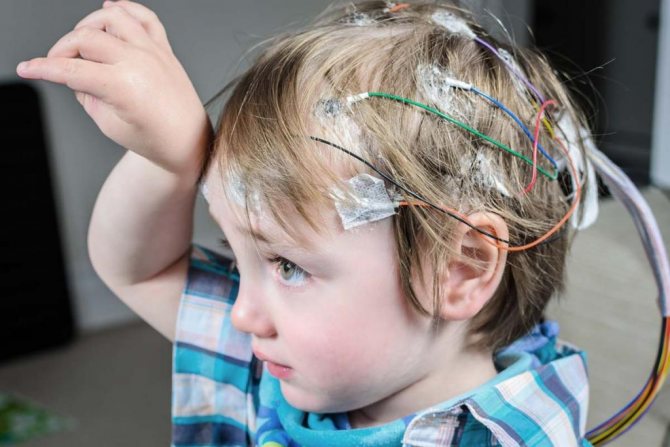
When marbled skin is complicated by elevated temperature, this indicates the presence of some kind of infection in the body. On the face there is a violation of heat exchange and vasospasm, hence the effect of marbled skin. In such a situation, you need to immediately take the patient to a doctor or call an ambulance, especially if the temperature is 40 degrees or higher.
How to treat?
Physiologically conditioned marbled skin does not require treatment. The condition goes away on its own and in a fairly short time, on average after 2-3 months. To help the child acquire strong vascular tone, parents can practice a daily strengthening massage, pouring cool water over the child after the main bath (according to the method of pediatrician Evgeniy Komarovsky, for example). The child will benefit from long walks in the fresh air, strengthening gymnastics and daily naked air baths.
It is good to practice early swimming. For the youngest (from 1 month), special orthopedic circles for the neck can be used for swimming.

A baby prone to skin marbling should absolutely not be overfed or overheated. This only intensifies the strange skin manifestations. Treatment of pathological causes depends on what specific disease is detected. Many problems with blood vessels and congenital heart defects, which manifest themselves at a very early age as marbling of the skin, require prompt or somewhat delayed surgical treatment.

Conservative therapy uses vascular drugs, vitamins, and physiotherapeutic procedures. The main goal of treatment is to increase blood microcirculation and strengthen the walls of blood vessels. Usually, the symptoms of marbled skin, if they are caused by pathology, disappear after the main cause that caused the problems with the blood vessels is eliminated. There are no medications that specifically help with strange skin color.
Most reliable medical sources cannot say anything about the treatment of congenital true marbling, since effective and proven methods of treating this extremely rare disease have not yet been developed. There are only hypotheses and theories.
Prevention
Preventive measures are aimed at preventing situations in which pallor and vascular spasms may appear. You need to monitor the temperature in the room with your baby. There should be no drafts and no temperature drop below 23 degrees Celsius. Comfortable air humidity is required - this is easy to achieve, just place a small basin of water next to the crib.
From the age of 1, you can begin to harden your child, but this should be done only after a full examination by a doctor and on his recommendation, since the baby may have hidden pathologies or simply have weak immunity.
It is very useful to give your baby air baths - at least once a day. For the normal development of the child’s skeleton and muscle tissue, it is necessary to massage him and perform gymnastics.
Many parents start their children swimming from the age of 4-5. This improves his health and has a therapeutic effect in many congenital diseases.
Breastfeeding can be continued for up to 1 year. Longer is not necessary, but less than 6 months will not be enough for the growth of a healthy child. It is very important to monitor the baby’s correct diet; a nutritionist will help balance the diet.
Many people believe that taking vitamins is necessary at any age. This is true, but everything should be done only as prescribed by the doctor - you should only take the medications that he prescribes. If you do it yourself, the situation may get worse in the end.

Diagnostics
If at some point the parents discovered signs of marbling of the skin in a newborn, there is no need to panic, but such a sign should also not be ignored. If the marble pattern appears again and again, you need to try to understand what factors favor it and be sure to tell your pediatrician about this at your next appointment.
If the child’s condition gives rise to more real concerns and there are other symptoms of possible pathology, then you should not hesitate to consult a doctor.
Depending on the baby’s condition, the doctor prescribes consultations with a cardiologist, pediatric neurologist, or rheumatologist. Diagnostic methods include ultrasound examination of the heart and large vessels, ultrasound examination of the brain (until the fontanel is tightened, and later MRI). An electrocardiogram and an encephalogram can tell specialists a lot about the baby’s health. It is possible that your child will need to consult a dermatologist.
How does lifestyle affect the skin?
In the modern world, all the most interesting things for a baby are on the other side of the monitor and TV screen. From the age of 2-3 years, parents accustom their children to cartoons and computer games. This is convenient - the baby is safe and does not require attention. You can safely go about your business.
But it is precisely this plant-based lifestyle that leads to the appearance of marbled skin.
You need to understand that for full development, the baby must walk more, exercise physically, and in any weather. Ideally, a child should be outside for 4-5 hours a day.
